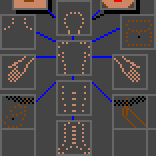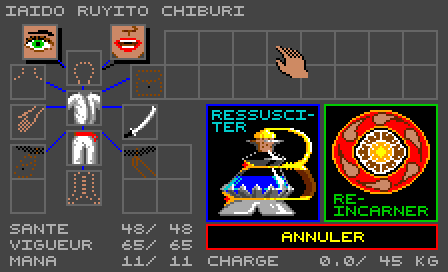Téléchargements
Exécutable de l'éditeur de niveaux - exactement le même que la partie 21 (Windows 32bits)
Exécutable du jeu (Windows 32bits)
Avant d'essayer de compiler le code, allez dans l'onglet "Projets" dans le menu de gauche, séléctionnez l'onglet "Run" pour votre kit,
et mettez dans "Working directory" le chemin de "editor\data" pour l'éditeur ou "game\data" pour le jeu.
Positions des objets
Une paire de bottes n'ira pas sur votre tête, certains objets sont trop grands pour rentrer dans votre poche, etc...
Alors chaque objet va être associé à une liste de positions possibles.
D'abord, regardons toutes les positions possibles.
Cette image vient de the Dungeon Master Encyclopaedia

Vous pouvez voir que chaque slot d'objet fait partie d'un groupe spécifique.
Pour faciliter les choses dans le code, on va identifier ces groupes par une seule lettre:
- H: Head (tête)
- N: Neck (cou)
- T: Torso (torse)
- L: Legs (jambes)
- F: Feet (pieds)
- h: Hands (mains)
- P: Pouch (poche)
- Q: Quiver1 (carquois 1)
- q: Quiver2 (carquois 2)
- B: Backpack (sac à dos)
- C: Chest (coffre)
- c: Consumable (consommable)
chaque caractère de cette chaine correspondra à cette liste.
<items>
<!-- ======================== Armes ======================== -->
<!-- OEIL DU TEMPS -->
<item name="ITEM001">
<category>Weapon</category>
<floor_image>00W_Ring.png</floor_image>
<image_file>Items0.png</image_file>
<image_num>17</image_num>
<position>hBCP</position>
</item>
[...]
</items>
Les parties du corps
Jusqu'à maintenant, on avait un enum avec toutes les parties du corps du personnage. On va le compléter avec tous
les slots d'objets possibles, y compris les poches, le carquois et le sac à dos (mais pas le coffre, parce qu'on en
parlera dans une autre partie).
#define BACKPACK_SIZE 17
class CCharacter
{
public:
enum EBodyParts
{
eBodyPartHead = 0, // tête
eBodyPartNeck, // cou
eBodyPartTorso, // torse
eBodyPartLeftHand, // main gauche
eBodyPartRightHand, // main droite
eBodyPartLegs, // jambes
eBodyPartFeet, // pieds
eBodyPartPouch1, // poche 1
eBodyPartPouch2, // poche 2
eBodyPartQuiver1, // carquois 1
eBodyPartQuiver2, // carquois 2
eBodyPartQuiver3, // carquois 3
eBodyPartQuiver4, // carquois 4
eBodyPartBackpack, // sac à dos
eBodyPartCount = eBodyPartBackpack + BACKPACK_SIZE
};
d'entiers, maintenant on va le remplacer par un tableau de CObject.
CObject bodyObjects[eBodyPartCount];
Définir les slots d'objets
On aura besoin de leur position, d'un caractère pour définir leur type d'après la liste qu'on a donnée au début, et
d'un entier pour dire si on doit dessiner un sprite par défaut quand il n'y a pas d'objet.
Ces sprites par défaut sont pour les images de la silhouette du corps, de la poche, du carquois et du sac à dos.

Comme ces sprites sont tous dans la même planche, on a juste besoin d'un entier pour le numéro du sprite.
Donc dans inventory.h, on aura un tableau de structures comme ça:
class CInterface
{
public:
[...]
struct SBodyInfos
{
CVec2 pos;
char type;
int defaultImage;
};
[...]
private:
[...]
SBodyInfos bodyInfos[CCharacter::eBodyPartCount];
};
CInterface::CInterface()
{
[...]
// initialise les positions des objets dans la feuille de personnage
bodyInfos[CCharacter::eBodyPartHead].pos = CVec2(34, 59);
bodyInfos[CCharacter::eBodyPartNeck].pos = CVec2( 6, 66);
bodyInfos[CCharacter::eBodyPartTorso].pos = CVec2(34, 79);
bodyInfos[CCharacter::eBodyPartLeftHand].pos = CVec2( 6, 86);
bodyInfos[CCharacter::eBodyPartRightHand].pos = CVec2(62, 86);
bodyInfos[CCharacter::eBodyPartLegs].pos = CVec2(34, 99);
bodyInfos[CCharacter::eBodyPartFeet].pos = CVec2(34, 119);
bodyInfos[CCharacter::eBodyPartPouch1].pos = CVec2( 6, 106);
bodyInfos[CCharacter::eBodyPartPouch2].pos = CVec2( 6, 123);
bodyInfos[CCharacter::eBodyPartQuiver1].pos = CVec2(62, 106);
bodyInfos[CCharacter::eBodyPartQuiver2].pos = CVec2(79, 106);
bodyInfos[CCharacter::eBodyPartQuiver3].pos = CVec2(62, 123);
bodyInfos[CCharacter::eBodyPartQuiver4].pos = CVec2(79, 123);
bodyInfos[CCharacter::eBodyPartHead].type = 'H';
bodyInfos[CCharacter::eBodyPartNeck].type = 'N';
bodyInfos[CCharacter::eBodyPartTorso].type = 'T';
bodyInfos[CCharacter::eBodyPartLeftHand].type = 'h';
bodyInfos[CCharacter::eBodyPartRightHand].type = 'h';
bodyInfos[CCharacter::eBodyPartLegs].type = 'L';
bodyInfos[CCharacter::eBodyPartFeet].type = 'F';
bodyInfos[CCharacter::eBodyPartPouch1].type = 'P';
bodyInfos[CCharacter::eBodyPartPouch2].type = 'P';
bodyInfos[CCharacter::eBodyPartQuiver1].type = 'Q';
bodyInfos[CCharacter::eBodyPartQuiver2].type = 'q';
bodyInfos[CCharacter::eBodyPartQuiver3].type = 'q';
bodyInfos[CCharacter::eBodyPartQuiver4].type = 'q';
for (int i = 0; i < BACKPACK_SIZE; ++i)
{
int x = 66 + ((i + 1) % 9) * 17;
int y = 49 + ((i + 1) / 9) * 17;
bodyInfos[CCharacter::eBodyPartBackpack + i].pos = CVec2(x, y);
bodyInfos[CCharacter::eBodyPartBackpack + i].type = 'B';
}
// images par défaut pour les parties du corps
for (int i = 0; i < CCharacter::eBodyPartCount; ++i)
bodyInfos[i].defaultImage = -1;
bodyInfos[CCharacter::eBodyPartHead].defaultImage = 24;
bodyInfos[CCharacter::eBodyPartNeck].defaultImage = 16;
bodyInfos[CCharacter::eBodyPartTorso].defaultImage = 26;
bodyInfos[CCharacter::eBodyPartLeftHand].defaultImage = 20;
bodyInfos[CCharacter::eBodyPartRightHand].defaultImage = 22;
bodyInfos[CCharacter::eBodyPartLegs].defaultImage = 28;
bodyInfos[CCharacter::eBodyPartFeet].defaultImage = 30;
bodyInfos[CCharacter::eBodyPartPouch1].defaultImage = 17;
bodyInfos[CCharacter::eBodyPartQuiver1].defaultImage = 18;
bodyInfos[CCharacter::eBodyPartBackpack + 8].defaultImage = 19;
}
Dessin et zones souris
void CInterface::drawBodyPart(QImage* image, CVec2 pos, int championNum, CCharacter::EBodyParts part, bool enableArea)
S'il y a un objet, on le dessine comme on a dessiné le curseur dans la partie précédente.
S'il n'y a pas d'objet dans ce slot, on dessine l'image par défaut définie dans bodyInfos.
J'expliquerai plus tard pourquoi on doit passer la position en paramètre à cette fonction au lieu de la récupérer
directement dans bodyInfos.
{
CCharacter* c = &game.characters[championNum];
int objType = c->bodyObjects[part].getType();
if (objType != 0)
{
// dessine l'objet dans ce slot
CObjects::CObjectInfo object = objects.mObjectInfos[objType - 1];
QImage objImage = fileCache.getImage(object.imageFile.toLocal8Bit().constData());
CRect rect = getItemRect(object.imageNum);
graph2D.drawImageAtlas(image, pos, objImage, rect);
}
else if (bodyInfos[part].defaultImage != -1)
{
// dessine l'image par défaut
QImage bodyParts = fileCache.getImage("gfx/interface/Items6.png");
CRect rect = getItemRect(bodyInfos[part].defaultImage);
graph2D.drawImageAtlas(image, pos, bodyParts, rect);
}
Ici on doit vérifier si l'objet que l'on tient peut aller dans ce slot en testant si le caractère qui définit ce
type de slot est contenu dans la chaine "positions" de l'objet.
Un paramètre supplémentaire "enableArea" permet de passer outre ce test. Je l'expliquerai plus tard aussi.
// zone souris
int objHandType = mouse.mObjectInHand.getType();
CRect mouseRect(pos, pos + CVec2(ITEM_WIDTH - 1, ITEM_HEIGHT - 1));
bool isPositionCompatible = true;
// Teste si l'objet qu'on tient peut être mis dans ce type de slot
if (objHandType != 0)
{
QString& positions = objects.mObjectInfos[objHandType - 1].positions;
isPositionCompatible = positions.contains(bodyInfos[part].type);
}
if (isPositionCompatible == true && enableArea == true)
mouse.addArea(eMouseArea_InvObject, mouseRect, eCursor_Hand, (void*)championNum, (void*)part);
}
for (int i = 0; i < CCharacter::eBodyPartCount; ++i)
drawBodyPart(image, bodyInfos[i].pos, currentChampion, (CCharacter::EBodyParts)i);
Tester les zones souris
void CInterface::update(SMouseArea* clickedArea)
{
[...]
if (clickedArea != NULL)
{
if (mouse.mButtonPressing == true)
{
switch (clickedArea->type)
{
[...]
// slot d'objet dans l'inventaire
case eMouseArea_InvObject:
{
// récupère le perso courant et la position dans l'inventaire
int champNum = (int)clickedArea->param1;
CCharacter* c = &game.characters[champNum];
int objectPos = (int)clickedArea->param2;
// échange l'objet que l'on tient avec celui dans l'inventaire
CObject temp = mouse.mObjectInHand;
mouse.mObjectInHand = c->bodyObjects[objectPos];
c->bodyObjects[objectPos] = temp;
}
break;
default:
break;
}
}
[...]
}
Ca marche même si la main ou le slot sont vides. Dans ce cas, il y a un objet normal avec seulement son type mis à 0.
On aurait pu gagner du temps en ne définissant pas de zone souris si à la fois le slot et notre main sont vides,
mais ça ne devrait pas trop ralentir le jeu. Quoi qu'il en soit, on sera dans le même cas si l'inventaire est plein
d'objets.
Les objets de départ des champions

On va définir ces objets dans "champions.xml" comme ça:
<!-- ELIJA -->
<champion firstName="CHAMP_FNAME00" lastName="CHAMP_LNAME00">
[...]
<object pos="T">52</object>
<object pos="L">53</object>
<object pos="F">50</object>
<object pos="21">133</object>
</champion>
raccourcis:
- H: Tête
- N: Cou
- T: Torse
- L: Jambes
- F: Pieds
- h: Main droite
- P: Premier slot de poche
Ces objets sont lus dans CCharacter::readCharactersDB() et stockés dans une liste de structures:
class CCharacter
{
[...]
private:
struct SDBObject
{
int pos;
int type;
};
struct SChampDBData
{
[...]
std::vector<SDBObject> objects;
};
[...]
};
void CCharacter::fromDB(int num)
{
[...]
for (size_t i = 0; i < eBodyPartCount; ++i)
bodyObjects[i].setType(0);
for (size_t i = 0; i < db.objects.size(); ++i)
{
int pos = db.objects[i].pos;
int type = db.objects[i].type;
bodyObjects[pos].setType(type);
}
}
Les mains en haut

Ils sont une copie des slots des mains dans la feuille de personnage.
On va donc utiliser le même identifiant pour les dessiner, mais ils ne sont pas à la même position.
C'est la raison pour laquelle on devait passer la position en paramètre à drawBodyPart().
void CInterface::drawChampion(QImage* image, int num)
{
[...]
// dessine les mains
mouse.addArea(eMouseArea_None, handMouseRect, eCursor_Hand);
drawBodyPart(image, CVec2(69 * num + 4, 10), num, CCharacter::eBodyPartLeftHand, !isResurrecting);
drawBodyPart(image, CVec2(69 * num + 24, 10), num, CCharacter::eBodyPartRightHand, !isResurrecting);
On doit désactiver ces slots quand on ressuscite un champion pour empêcher le joueur de voler ses objets en les
mettant dans les mains d'un autre champion.

De plus, j'ai ajouté un test pour empêcher de cliquer sur les boutons "Ressusciter" ou "Annuler" quand on tient un
objet. Ca suit le comportement du jeu d'origine.